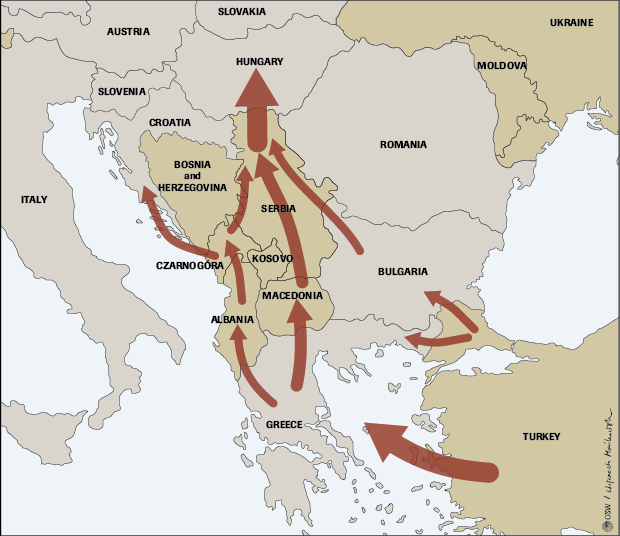Migration pressure on the Hungarian border
Since 2014 the number of immigrants from Syria and Afghanistan attempting to enter the EU illegally via the Western Balkans countries has significantly increased. According to the EU agency FRONTEX, in the first five months of 2015 more than 50,000 people have been detained after attempting to illegally cross the EU border with the Balkan states. This is larger than the number of people detained after attempting to enter the EU via the most popular route through the Mediterranean Sea to Italy and Malta. The countries of the region – which are not the final destination of the immigrants –are yet to any measures in order to halt the illegal influx of people and have even helped them on their way. There has been a substantial increase in the number of migrants coming to the EU and this has sparked disagreements among member states regarding the redistribution of refugees in EU member states and has led to Hungary becoming more involved in this area. By using harsh rhetoric and presenting controversial solutions (such as the construction of a fence on the Hungarian-Serbian border) Budapest has succeeded in drawing attention to the growing problem of migration also in this region. Furthermore, Hungary will be excluded from the refugee redistribution system with the EU and it has received 8 million euros from the European Commission in support for its migration policy. These measures have not however solved the problem of the significant increase in the number of illegal immigrants arriving in the EU via the Balkans and according to forecasts this trend will continue to intensify. The presented solutions, which are limited to stepping up border control, will only lead to immigrants modifying the route they are taking.
An increase in the popularity of the Balkan route
FRONTEX had already reported an increase in the number of people trying to cross the border illegally between the EU and the Balkan states in 2014. Most people were detained at the 175 km long section of the border between Hungary and Serbia. This increase is due to the growing popularity of this route with people coming from Syria and Afghanistan as well as a violent exodus of Kosovars. The intensive migration of Albanians, which lasted from November 2014 to March 2015, has been halted. This was achieved due to enhanced border controls and an information campaign in Kosovo aimed at Albanians, telling them they did not stand a chance of obtaining legal domicile status in the EU.
In the first half of 2015 there was an important increase in the number of immigrants from Afghanistan and above all from Syria. Due to the reinforced supervision of the eastern part of the Mediterranean Sea, the route cutting through Greece and Macedonia or Bulgaria and further through Serbia to Hungary is at present the cheapest, safest and quickest. Furthermore, it enables migrants to directly reach the Schengen zone. The policy Greece has taken has also facilitated the intensification of migratory flows through the Balkans since Greece does not usually register coming refugees and allows them to move on to Western Europe, contrary to EU regulations. These refugees thus still have the right to apply for refugee status in richer EU countries, most frequently in Austria, Germany and Sweden.
Hungary’s response
Hungary as a transit country for immigrants has not taken significant measures aimed at curbing the number of migrants. According to the Hungarian Office of Immigration and Nationality, 80% of those coming to Hungary leave the country within ten days of applying for refugee status. Hungary’s present activity is linked to an increased wave of refugees coming from the direction of the Balkans and the fact that the destination countries for the migrants (mainly Germany and Austria) have announced they are going to enforce EU regulations more effectively and send those people back to Hungary who first applied for refugee status there.
On 23 June Hungary went so far as to announce the suspension of EU regulations in this area. However, strong protest from Austria (it threatened to reinstate border controls) led to Hungary reversing its decision. Raising the question of the considerable influx of migrants is also an element of pressure which Hungary is applying on its EU partners. The Hungarian government is calling for an EU summit to be organised in autumn in Budapest, arguing that the EU is only concerned with the Mediterranean route (a summit in Malta is planned in September). Hungary is also opposed to the introduction of mandatory quotas of refugees to be redistributed among EU member states. This proposal was rejected by the European Council on 25-26 June and under the voluntary redistribution of quotas Hungary and Bulgaria will have special status due to high migratory pressure in these countries. The Hungarian government has also announced that it will introduce a series of regulations which may be incompatible with EU law, including the right to detain people applying for refugee status in closed centres (they will have to work to cover the cost of this stay), a shorter period of processing applications, and measures to facilitate the deportation of illegal immigrants. On 17 June the Hungarian government said that it would build a 4 meter fence along the 175 km section of its border with Serbia (the cost has been estimated at 20 million euros).
On the other hand, the Hungarian government is using the issue of immigration on its domestic scene. The anti-immigration campaign which has been running for several months has dominated public debate, diverting attention from the ruling party Fidesz’s problems and reversing the trend of falling support for the party. As part of the “national consultations” programme the government has sent all citizens a letter from Prime Minister Viktor Orban and a questionnaire which suggests there are links between immigrants and terrorism. Once again the government has run a huge billboard campaign (with slogans saying “If you come to Hungary, you cannot take jobs away from Hungarians”, “If you come to Hungary, you must obey our laws” etc.). These are aimed not at immigrants, as the slogans are written only in Hungarian, but to Hungarian citizens.
The other states in the region
The countries in the region which lie outside the EU are harmonising their regulations regarding migration policy with EU law. However, as countries surrounded by EU member states, they do not deem it necessary to develop centres or assistance systems for migrants coming from outside Europe. Even more so that Serbia, Bosnia and Herzegovina, and Croatia have not yet resolved the problem of refugees and people displaced due to the wars in the 1990s. In Serbia alone they number 271,000. At present none of the Balkan states has the logistic capacity to deal with a growing wave of refugees. In Serbia, although the number of those declaring their willingness to be granted asylum has substantially risen (16,000 in 2014), this has led to only 388 applications submitted and 6 people were granted asylum.
Officially, the governments in Belgrade and Skopje declare they are willing to cooperate with the EU in order to stop the wave of migration. The Serbian government signed a memorandum with the governments of Austria and Hungary on border protection which makes provision for joint border patrols and enhanced co-operation between border services. The current help from the EU is however insufficient for the countries of the region, which lack the funds, equipment and organisational capacities required to effectively control their borders in the face of large numbers of refugees. The Serbian and Macedonian governments underline that this problem is caused by insufficient protection of the EU border by EU member states, meaning Bulgaria and Greece. The Serbian government points out that the region is only a transit area between Greece and Hungary which are part of the Schengen zone and that this problem should therefore be dealt with by the EU.
The outlook
The problem with the uncontrolled influx of refugees through the Western Balkans will worsen. The measures taken so far, such as reinforcing police patrols on the Serbian-Hungarian border or the Macedonian-Serbian border in co-operation with Austria and Germany, are merely an interim solution and can only lead to a modification of the migratory routes. The clear lack of equipment and personnel in all the countries in the region will make it impossible for them to tighten controls all along their borders.
Even though Hungary has recently succeeded in drawing attention to the problem of the Balkan migratory route and has avoided the introduction of compulsory quotas of refugees, in the long term the fact that refugees are not prevented from coming to the EU through Hungary will strengthen the trend to reinstate border controls on the Hungarian border by neighbouring countries. Building a fence on the Hungarian-Serbian border may be interpreted as Hungary’s attempt to symbolically break with the Western Balkans and write off Budapest’s years of efforts to establish close relations with the countries in the region. This dispute may affect above all the good relations between Hungary and Serbia, the improvement of which was one of the major achievements in foreign policy pursued by the Orban government and it is even more visible against the backdrop of tensions with Hungary’s EU partners.
Migration statistics 2012-2015
|
|
2012 |
2013 |
2014 |
01 – 05.2015 |
|
Number of people detained while illegally entering the EU via the Western Balkans. |
6 391 |
19 951 |
43 357 |
50 430 |
|
Number of people applying for refugee status in Hungary, including: |
2 157 |
18 900 |
42 777 |
ok. 46 000 |
|
- those granted refugee status |
87 |
198 |
240 |
b.d. |
|
- those granted additional protection |
328 |
217 |
236 |
b.d. |
|
- those holding tolerated stay permits |
47 |
4 |
7 |
b.d. |
Data from: Frontex, Hungarian Statistical Office, and the Hungarian Office of Immigration and Nationality
Map
Main routes of illegal migration to south-eastern Europe

Source: FRONTEX





